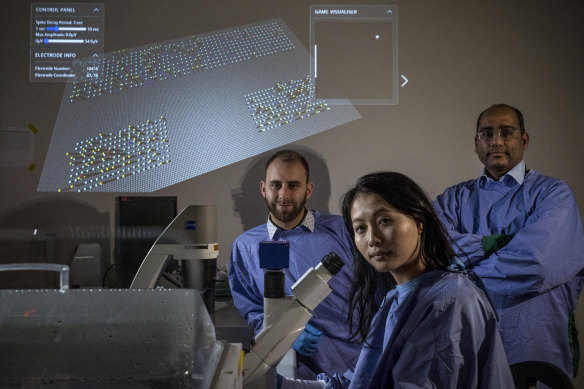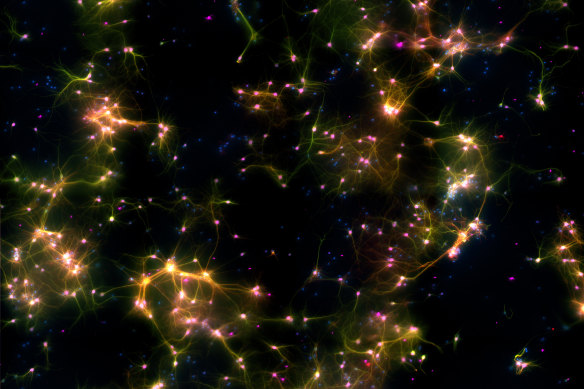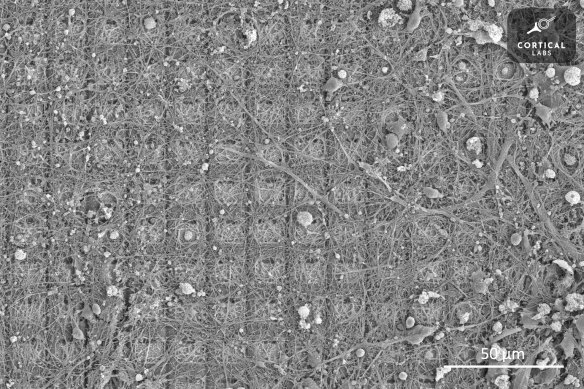In a world first, Melbourne-based scientists have trained a dish of human brain cells to play the video game Pong.
The team describe their work as a “cyborg brain” and in a paper published on Thursday in leading journal Neuron claim it is showing signs of sentience – but not consciousness.
Dr Brett Kagan, Dr Nhi Thao Tran and Dr Adeel Razi with, in the background, a representation of the neurons and the game Pong.Credit:Chris Hopkins
The cyborg is primitive. It contains fewer neurons than a bumblebee’s brain and barely hits the Pong ball more often than it misses.
But the researchers believe it opens a new field of “synthetic biological intelligence” – a possible avenue to realising dreams of a true generalised artificial intelligence.
Current AI programs are “inspired by the human brain”, says Dr Brett Kagan, the study’s lead author and chief scientific officer of biotech start-up Cortical Labs. “Why would we try to mimic what we can harness?”
The researchers grew a layer of human neurons and placed them on top of an electrode array, which they connected to the classic ping-pong game Pong.
A microscope image of DishBrain, showing connections forming between the neurons.Credit:Cortical Labs
The array sent electrical pulses into the neurons representing where the ball was. Two regions recorded signals from the neurons and moved the game’s paddle up and down accordingly.
If the cells hit the ball, they received a strong, consistent feedback signal. If they missed they got a short random pulse.
Compared with cells getting no feedback, the cells hooked into Pong played the game slightly better after five minutes. After 20 minutes of gameplay, they were even better still – evidence the neurons were building networks, reorganising and learning.
“This development represents a big step for artificial biological neural networks,” said Professor Anton van den Hengel, founding director of the Australian Institute for Machine Learning. He was not involved in the study.
Despite big advances, AIs remain far less intelligent than animals, in part because of the enormous amount of computing power and electricity the most powerful models need. Biological computers don’t have that limitation because neurons are so energy efficient, van den Hengel said.
Professor David Winkler, a Monash University machine-learning researcher who was not involved in the research, noted the study was small – “as most paradigm-shifting studies often are” – and while valid, the results had a significant degree of experimental uncertainty around them.
“But it’s a really exciting start, and people will build on this,” he said. “With more sophisticated experiments, I wouldn’t be surprised if the learning improved substantially.”
The researchers believe the DishBrain, as they call it, is far too primitive to have consciousness.
But future research in the area will open “huge” ethical questions, said Dr Adeel Razi, director of Monash University’s Computational and Systems Neuroscience Laboratory and a co-author on the paper.
A scanning electron microscope image of a neural culture that has been growing for more than six months on a high-density multi-electrode array. A few neural cells grow around the periphery and have developed complicated networks that cover the electrodes in the centre.Credit:Cortical Labs
Computers are tools humans use – but biological computers might be more like colleagues.
“You collaborate with them, rather than telling them what to do,” he said. “Do they have feelings, consciousness? Are they conscious of what’s happening around them? We don’t know. We don’t think they are conscious in any way – but they could be in the future.”
Professor Robert Sparrow, a philosopher who studies the ethics of technology at Monash University, said the simplicity of the DishBrain meant it did not immediately raise ethical concerns. “But the claim about sentience rings alarm bells for future research in this area.”
The team next plans to study the effect of alcohol on the cells. “Basically, get them ‘drunk’ and see if they play the game more poorly,” said Kagan.
Since the team uploaded a preprint of their study last year, three major biological computer projects have been launched in the US and Europe. Kagan hopes it heralds a new dawn for the field and opens a path towards true artificial intelligence.
For years, AI research has focused on using computers to simulate neural networks; this approach works well for specific applications such as playing video games, but has not yet generated a true artificial intelligence.
“Maybe it’s time to try a new approach,” said Kagan. “The only proof we have of a general intelligence system is done with biological neurons – which is us.”
Cortical Labs is a venture capital-funded startup; Kagan is an employee and shareholder, and holds patents related to the study.
The Morning Edition newsletter is our guide to the day’s most important and interesting stories, analysis and insights. Sign up here.
Most Viewed in National
From our partners
Source: Read Full Article



